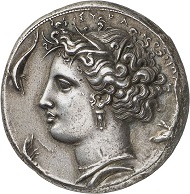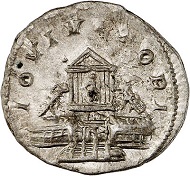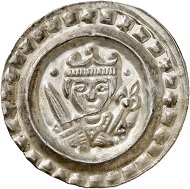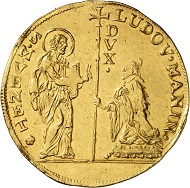05-03-2017 – 07-03-2017
Auctions 244-246
Rarities from the collection of a Munich-based doctor
Three auctions will be conducted by Gorny & Mosch from March 6-8, 2017, immediately after the Munich Numismata. The highlight auf Auction 244 is a series of Syracusan decadrachms with rarities created by Kimon and Euainetos. And Auctions 244 and 245 will offer, among other things, the collection of a Munich-based doctor. Assembled between the 1960s and the late 1990s, the ensemble consists of ancient coins of an outstanding quality. Auction 245 will provide ancient coins for the collector with not too big a budget as well as the multiple lots Gorny & Mosch is virtually renowned for. Auction 246 with coins from medieval and modern times present numerous specialized series, including a collection Henneberg, a collection Hohnstein, and a small batch of Goetz medals. As for the foreign department, the main protagonists here are a series of Venetian gold, numerous coins from Norway and Russia as well as a collection of Hungarian gold gulden and ducats.
On March 10, 2017, starting at 4 p.m., Gorny & Mosch will hold its first e-auction as Auction 247. It comprises of the Laurent Bricault Collection featuring depictions of the Egyptian deities Isis and Sarapis on ancient coins.
Lot 9: Celts. Imitation Thasos. Class III. Tetradrachm, after 148, unknown mint. From the collection of a Munich-based doctor. Extremely fine. Estimate: 750,- euros.
Auction 244 – High-quality Ancient Coins
673 coins of the finest quality – ranging from the Celts to Byzantium – will be offered in Auction 244. The sale will start with nine Celtic strikings, already including the first coins from the collection of a Munich-based doctor. It only takes one look at these coins to realize with how great an eye for appeal and extraordinary quality this collector has made his choices. A telling example is the imitation of the Hellenistic tetradrachms from Thasos whose reverse feature Dionysus with a necklace. The piece is sharply struck, perfectly centered and comes in extremely fine (estimate: 750 euros).
Lot 98: Syracuse (Sicily). Decadrachm, ca. 400-390. Extremely fine. From the Comte René Philipon (1870-1936) and Aynard collections, Auction 1913, Lot 22. Estimate: 50,000,- euros.
Greek coins
The department of Greek coins consists of nearly 380 lots with select strikings of the finest quality, with some objects’ provenance dating back quite some time. Some of the six Syracusan decadrachms, for instance, can be traced back as early as the beginning of the 20th century. The highlights, of course, are the magnificent works by Kimon and Euainetos. The series will be kicked off by two unsigned works of Kimon, showing a monumental head of Arethusa with her hair bound in a hairnet (estimate each: 50,000 euros). They are followed up by a decadrachm of Euainetos with the head of Arethusa in Classical style that was to become the model of Greek coinage for more than a century to come (estimate: 50,000 euros). Who can’t spend that much on a decadrachm ought to have a look at the remaining three coins whose estimates range between 7,500 and 15,000 euros.
Lot 235: Simon, Dynast (Illyria). Tetradrachm, ca. 355. Unique, HGC cover picture. From the collection of a Munich-based doctor. Good extremely fine. Estimate: 15,000,- euros.
The collection of a Munich-based doctor is at the center of attention, especially when it comes to Northern Greece. It was this area that attracted the collector’s interest most of all. His six strikings from Damastion could be labelled a specialized collection in their own right. But a unique coin such as the extremely fine tetradrachm of the otherwise unknown Illyrian dynast Simon deserves mentioning, too (estimate: 15,000 euros). We shouldn’t omit the strictly not that rare strikings of the Macedonian and Paionian rulers who can rarely be encountered on the market in such a perfect grade! To address only one case in point: an extremely fine tetradrachm of Philip V, with the bust of the ruler in the guise of Perseus forming the center of a Macedonian shield (estimate: 2,000 euros).
Lot 369: Eucratides, ca. 171-145 (Bactria). Gold stater, Baktra Mint. Extremely fine. Estimate: 20,000,- euros.
Let’s conclude this preview of Greek coins with some extremely rare gold coins, as an interesting gold dinar of Shapur III (EF-FDC; estimate: 7,500 euros), a gold stater of Eucratides from the Baktra Mint (EF; estimate: 20,000 euros), and an octodrachm for the Egyptian ruler Arsinoe II (EF-FDC; estimate: 20,000 euros).
Lot 395: Philippopolis (Thrace). Antoninus Pius, 138-161. AE medallion. Dark brown patina. Smoothed. Extremely fine. Estimate: 1,200,- euros.
Roman provincial strikings
Who takes an interest in perfect provincial coinage, can’t get past this catalog. It contains a number of these, supplemented by a small series of cistophoroi. The highlights constitute of an enchanting portrait of Octavia, first wife of Emperor Nero, on a bronze from Perinthos (EF; estimate: 1,500 euros) and the perfectly preserved depiction of the river deity Hebros from Philippopolis (EF; estimate: 1,200 euros). And there is the medallion featuring the image of Antinoos, funded by Polemon from Smyrna, that is very likely to find many admirers (VF; estimate: 2,500 euros).
Lot 497: Diva Ulpia Marciana, + 112. Sestertius, 112-117, Rome. Glendining “The Ryan Sale” (1952), Lot 2455. Good very fine. Estimate: 7,500,- euros.
Roman coins
Rarities in gold, silver and bronze constitute the Roman part of Auction 244. The spectrum ranges from a fragment of an aes signatum bar to solidi of the Roman rulers of the 5th century.
Among the strikings from Imperial times, the connoisseur discovers wonderful bronzes, such as a sestertius with the portrait of Agrippina Maior, although – as often found with this coin – slightly smoothed (EF; estimate: 6,000 euros). Of great rarity is the sestertius on Diva Marciana Trajan had minted in honor of his sister (good VF; estimate: 7,500 euros).
Lot 538: Pertinax, 192-193. Aureus, 193, Rome. From the collection of a Munich-based doctor. Extremely fine. Estimate: 25,000,- euros.
Spectacular to see are the aurei and solidi, including the strikings of Lucilla (EF; estimate: 10,000 euros), of Pertinax (EF; estimate: 25,000 euros), of Septimius Severus (EF-FDC; estimate: 20,000 euros), of Galerius (EF-FDC; estimate: 12,000 euros), of Magnentius (FDC; estimate: 12,000 euros), and of Basiliscus (FDC; estimate: 6,000 euros).
Lot 568: Severus Alexander, 222-235. Denarius, 224, Rome. Extremely fine. Estimate: 15,000,- euros.
If you prefer silver coins, you can look also forward to rarities of which we would like to single out just two: Among the coins of Augustus there is the silver strike of a die hitherto only known as an aureus: On its obverse it shows two laurel branches and on the reverse the inscription OB CIVIS SERVATOS in a laurel wreath (EF; estimate: 1,500 euros). Historically very significant is a denarius of Severus Alexander with the depiction of the temple of Jupiter Victor from AD 224, that carries the circumscription IOVI VLTORI (EF; estimate: 15,000 euros).
Auction 245 – Ancient Coins and Lots
The second auction of ancient coins comprises almost 1,000 lots which will present the material with a slightly lower appraisal. The collectors can find numerous rarities in appealing grade here as well. A part of the fractions from the collection of a Munich-based doctor as well as his comprehensive collection of Roman denarii and antoniniani and of Byzantine coins are listed in this auction. They are just as much worth taking a good look at as the small series of strikings of the Bosporan Kings.
The multiple lots in particular deserve to be examined in detail. Everybody interested in Sasanian coins, for example, can choose between 11 multiple lots and may get himself, upon acquiring two lots of literature, virtually a specialized library on Sasanian coinage. Also the collectors of weights should study the multiple lots. Distributed among several multiple lots, a comprehensive specialized collection will cross the auction block.
Auction 246 – Medieval and Modern Times
March 8, 2017 is entirely devoted to coins and medals from medieval and modern times. Almost 1,000 lots will come under the hammer, including a large number of interesting single items and, most notably, many collections.
Lot 3027: Ulm. Konrad IV to Konradin, 1237-1254-1268. Bracteate around 1250. Extremely rare. Extremely fine to FDC. Estimate: 3,000,- euros.
Medieval coins
The auction sale will kick off with 30 medieval coins, among them rarities such as an extraordinarily well preserved Ulm bracteate, struck around 1250, featuring a crowned half-length portrait with sword and lis-tipped scepter (EF-FDC; estimate: 3,000 euros).
Lot 3051: Bavaria. Karl Theodor, 1777-1799. Vikariatstaler, 1790, Munich. On the vicariate. 2nd known specimen. Extremely fine to FDC. Estimate: 15,000,- euros.
German coins and medals
Nearly 300 coins from the German States and 50 post-1871 strikings follow. In this department, some remarkable individual items stand out, for example a Bavarian vikariatstaler of Karl Theodor from 1790 with half-length portrait to the left(!), struck in Munich (EF-FDC; estimate: 15,000 euros), a taler of Sebastian von Hatzfeld, struck in Nuremberg with the date 1597 (EF; estimate: 8,000 euros), and the first strike of a 1/4 taler 1744 of Karl Eugen von Wuerttemberg, struck in Stuttgart (FDC; estimate: 10,000 euros).
Lot 3106: Henneberg-Schleusingen. Wilhelm V, 1480-1559. Taler, 1555, Schleusingen. Very rare. Almost extremely fine. Estimate: 1,500,- euros.
Furthermore, two collections will be auctioned off, including a batch of more than 40 coins coming from the Princely County of Henneberg, minted from the yield of the Ilmenau Mines between 1691 and 1699, as well as about 100 lots containing strikings from the Counts of Hohnstein, issued between 1535 and 1592. For their coinage, the Counts of Hohnstein benefited from the rich silver deposits of the mines located in the vicinity of the city of St. Andreasberg which they granted the city privileges in 1535. That is why they had St. Andreas (St. Andrew) depicted on the reverse of their coins.
In der medal section, the connoisseur will find almost 40 Goetz medals, some of them rare.
Lot 3744: Russia. Alexander I, 1801-1825, for Poland. 50 zlotychs polsk, 1817, Warsaw. Very fine to extremely fine. Estimate: 5,000,- euros.
Foreign coins including a number of Russian strikings
Approximately 500 lots of coins and medals from foreign countries constitute the second part of the auction sale. The focus is on Norway, with 50 lots, and on Russia, with 80 lots, which of course contain a number of rarities. To highlight two of these: a striking for Alexander I for Poland in the value of 50 zlotychs, produced in Warsaw in 1817 (VF-EF; estimate: 5,000 euros), and a number of patterns for 10, 3 and 1 zolotniks from the reign of Alexander III.
When it comes to modern times, the relevant multiple lots have become virtual icons, too. Almost 30 will cross the auction block in Auction 246, such as a batch of Thai bullet money, of different weight, in the value of 2 bahts down to 1/64 baht (11 objects; estimate: 500 euros).
Lot 3622: Venice. Ludovico Manin, 1789-1797. Multiplo da 10 zecchinis n. d. Very rare. Hardly visible traces of mounting. Extremely fine. Estimate: 12,000,- euros.
Collection Venice
One of the unchallenged highlights of Auction 246 is a large collection – more than 80 lots in number – of gold coins from Venice. Several great rarities can be found among these, like a ducat of Niccolo Tron (1471-1473), better known to numismatists because of his introduction of his lira tron (EF; estimate: 7,500 euros). Also rare are the ducats of Marcantonio Trevisan (almost FDC; estimate: 1,500 euros) and Niccolo Sagredo (EF; estimate: 2,000 euros), who were Doge of the Serenissima for less than a year, or rather one and a half year, respectively. Last but not least, the 10 ducat piece of Ludovico Manin, the last Doge of the city of Venice, of course is also spectacular (EF; estimate: 12,000 euros).
Lot 3821: Hungary. John Hunyadi, 1446-1462. Gold gulden n. d. Extremely rare. Extremely fine to mint state. Estimate: 6,500,- euros.
Collection Hungary
A comprehensive collection of Hungarian gold gulden and ducats is listed almost at the end of the catalog. Chronologically speaking, the spectrum ranges from the early gold gulden of Charles Robert of Anjou, minted between 1325 and 1342 by the Buda Mint, and the ducats of the double monarchy of the House of Habsburg under Francis Joseph. The two most outstanding specimens are two gold gulden of John Hunyadi (1446-1452) from Nagybanya, graded extremely fine to mint state (estimate: 6,500 euros and 5,000 euros).
Everybody interested in Hungary should make sure to browse the pages introducing the multiple lots for they offer strikings from medieval and early modern times in meaningfully assembled multiple lots at collector-friendly estimates.
All catalogs may be ordered at Gorny & Mosch, Giessener Münzhandlung, Maximiliansplatz 20, D-80333 Munich, phone +49 / (0)89 / 24 22 643-0, fax +49 / (0)89 / 22 85 513. They can also be viewed online: 244, 245, 246.
By the way, it will be worth your while to consult the online catalogs, since images of many coins and medals, which didn’t find a spot in the printed catalogs, are available online.































